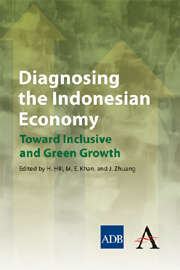Book contents
- Frontmatter
- Foreword
- Preface
- Author Profiles
- Abbreviations and Acronyms
- Contents
- 1 Introduction
- 2 Development Policies and Performance
- 3 Critical Constraints to Growth
- 4 Critical Constraints to Reducing Poverty and Inequality
- 5 Macroeconomic Management
- 6 Industrialization: Patterns, Issues, and Constraints
- 7 Infrastructure Development: Challenges and the Way Forward
- 8 Human Capital and Economic Development
- 9 Economic Growth, Employment Creation, and Poverty Alleviation
- 10 Poverty Reduction: The Track Record and Way Forward
- 11 Decentralization
- 12 Making Indonesia's Growth Green and Resilient
- Index
6 - Industrialization: Patterns, Issues, and Constraints
Published online by Cambridge University Press: 05 May 2012
- Frontmatter
- Foreword
- Preface
- Author Profiles
- Abbreviations and Acronyms
- Contents
- 1 Introduction
- 2 Development Policies and Performance
- 3 Critical Constraints to Growth
- 4 Critical Constraints to Reducing Poverty and Inequality
- 5 Macroeconomic Management
- 6 Industrialization: Patterns, Issues, and Constraints
- 7 Infrastructure Development: Challenges and the Way Forward
- 8 Human Capital and Economic Development
- 9 Economic Growth, Employment Creation, and Poverty Alleviation
- 10 Poverty Reduction: The Track Record and Way Forward
- 11 Decentralization
- 12 Making Indonesia's Growth Green and Resilient
- Index
Summary
Introduction
The industrial sector is well suited to a study of Indonesia's development constraints. The sector's growth and performance have been highly episodic and variable. Unless one could argue (implausibly) that the growth of variability is explained primarily by external, demandside factors, then an examination of domestic, supply-side factors will hold the key to understanding the constraints to rapid industrialization, and to economic growth more generally. Industrialization has also been at the heart of practically every major Indonesian policy debate, ranging from the costs and benefits of globalization through to the connections between the development of small and medium-sized enterprises (SMEs), employment growth, and poverty alleviation. Therefore the industrial policy environment is a prism through which the country's broader policy debates and issues may be examined.
This chapter analyzes and explains the patterns and performance of Indonesian industrialization since the 1960s, and connects these outcomes to a range of development constraints, including (1) the availability of complementary inputs, especially infrastructure, to ensure that markets perform effectively; (2) regulatory and other policy impediments to industrial growth; and (3) the rapidly changing international economic context. Of particular importance in the latter category are the changing terms of trade and hence the real exchange rate (relevant for a major commodity exporter such as Indonesia), the rise of the People's Republic of China (PRC) as an industrial superpower, and the growing importance of international production networks and buying chains.
- Type
- Chapter
- Information
- Diagnosing the Indonesian EconomyToward Inclusive and Green Growth, pp. 183 - 226Publisher: Anthem PressPrint publication year: 2012
- 3
- Cited by



